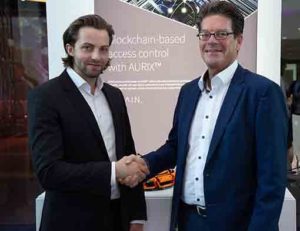Munich, Germany – 25 October 2018 – Infineon Technologies and XAIN have agreed to work together on bringing blockchain technology into the car. The Munich semiconductor maker and the Berlin-based start-up have signed a corresponding Memorandum of Understanding at Infineon’s 1st Automotive Cybersecurity Forum, taking place today in Munich. The goal of the collaboration is to test possible applications and develop suitable ones to market maturity. A first demonstrator shows how access rights, e.g. for car sharing, can be granted decentrally with a smartphone app.
“Cybersecurity is crucial for the data-driven mobility of the future”, says Peter Schiefer, President of Infineon’s Automotive Division. “Blockchain technology has enormous potential in this regard, but its use requires a high degree of coordination between the selected blockchain methodology and the security hardware installed in the car itself. We will be working together with XAIN to achieve this level of configuration.”
A blockchain is a decentralized database that enables speedy transactions and particularly secure, tamper-free storage. In connection with cars, feasible applications for this technology include automated payments, keyless access for car sharing schemes, on-demand services, tuning protection and automated driving functions. Essentially, it is all about the granting of access rights – to the car itself or to specific data in the vehicle. An example involving specific data is when insurance companies offer low rates for car owners with good driving habits.

All of Infineon’s 2nd generation AURIX microcontrollers can provide support for blockchain functionality in cars already today. This support is based on an embedded hardware security module (HSM) that complies with the highest level of the EVITA security standard. An HSM consists of special computing and storage units within the microcontroller. It performs the cryptographic operations and is protected by a dedicated firewall of its own. The 2nd generation AURIX microcontrollers thus have a secured memory for the digital key used for identification in the blockchain and are able to perform blockchain operations, such as hashing or digital signing, swiftly and securely. Certified security controllers such as the OPTIGA TPM 2.0 from Infineon for automotive applications allow even higher security levels to be reached.
However, the creation of new data blocks still represents a challenge for the conventional microcontrollers used in cars. Due to the enormous amounts of required computing power, the so-called mining as used in the context of cryptocurrencies, up to this point in time has been executed by high-performance processors. XAIN, however, is working on a new process that can also be performed on devices that need to be economical in their use of energy – such as microcontrollers in cars.
“We aim to turn cars into fully-fledged network participants”, says Leif-Nissen Lundbæk, founder and CEO of XAIN AG. “As well as being important for offline and real-time capabilities, this also enables a particularly high level of privacy protection in connection with AI technologies. It ensures that private data for machine learning is kept exclusively in local storage. The goal of our collaboration with Infineon is to advance the use of XAIN’s AI technology in cars.”
At the Infineon Automotive Cybersecurity Forum, Infineon and XAIN are presenting their first demonstrator. It shows how access rights can be granted decentrally, swiftly and securely by means of a smartphone app. An application for this would be a car sharing scheme without a platform or back-office in which all participants are able to spontaneously share their cars with others. The Infineon Automotive Cybersecurity Forum is the first industry conference staged by Infineon at which automotive companies, suppliers and academics have come together to discuss cybersecurity in vehicles.
About Blockchain
A blockchain is a decentralized database that enables speedy transactions and particularly secure, tamper-free storage. It stores the transactions in data blocks. The blocks are chained together in chronological order, each block containing a reference to the previous block. Any attempts to tamper with a block of stored data are easily detectable through the subsequent blocks. The fact that the blockchain is stored decentrally at many different locations simultaneously affords further protection against tampering – new blocks can always be checked by several other participants.
Further information is available at www.xain.io
















